Handbook of Nutraceuticals
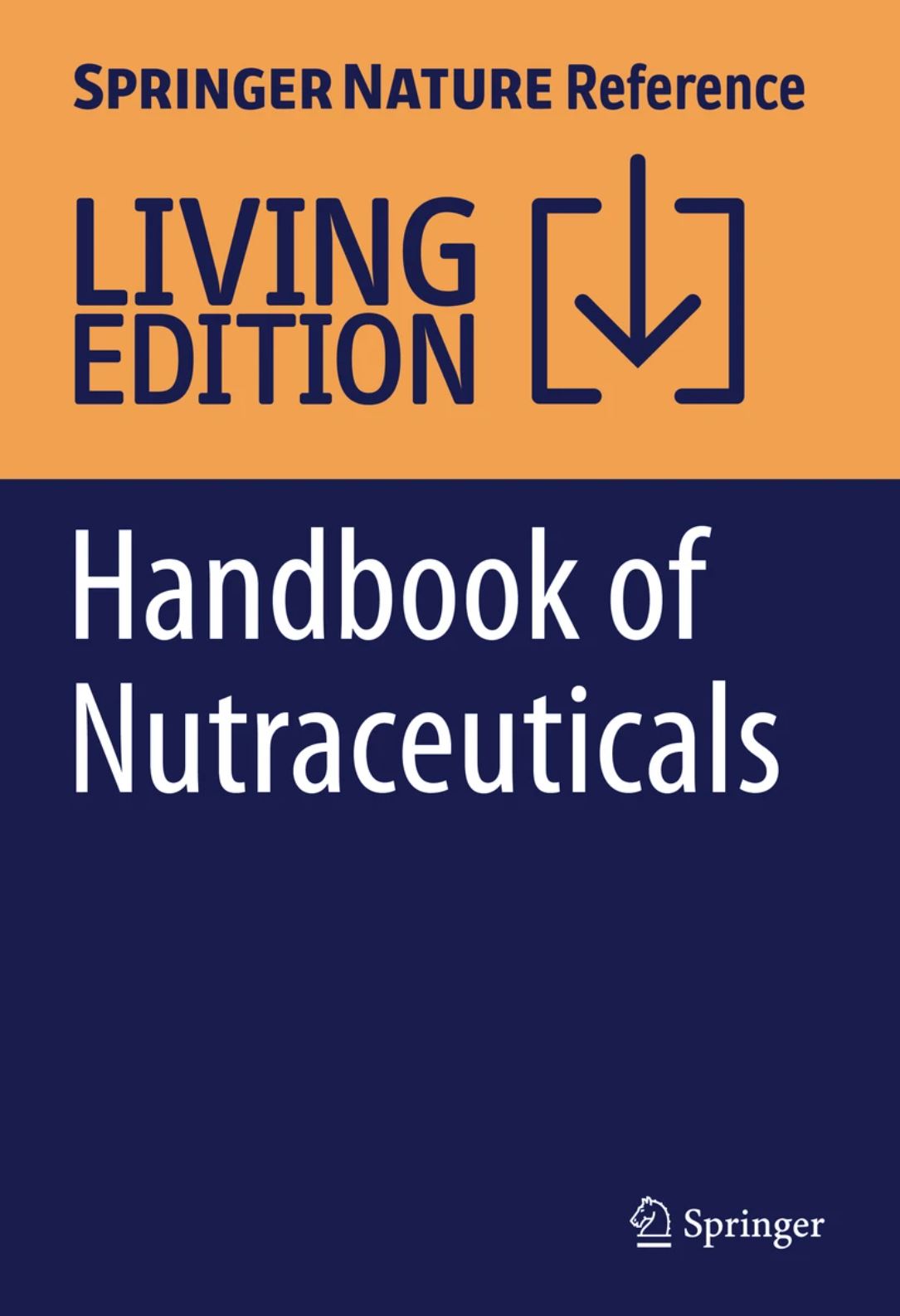
See the new book, edited by R. Rajakumari and Sabu Thomas.
Overview:
- Cutting-edge interdisciplinary book focused on the nutraceuticals and nano nutraceuticals
- Discusses all analytical techniques relevant to this field
- Assists on solving fundamental and applied problems in nutraceuticals and nano nutraceuticals
Description: This book covers different stages of development of nutraceuticals and nano nutraceuticals, emphasizing their manufacturing techniques and formulations. The physicochemical behaviour of nutraceuticals and nano nutraceuticals and innovative characterization techniques are presented. Various types of formulation methods and pharmacologic and pharmacokinetic evaluations are described. Moreover, the controlled delivery of nutraceuticals and nano nutraceuticals components is covered in several chapters. The book reviews various classes of natural and biodegradable polymers used to prepare nutraceuticals and nano nutraceuticals based delivery system. It provides details about in vitro evaluation for testing the effectiveness of nutrient delivery systems. The bioavailability, food additives, and encapsulation techniques are discussed. A chapter on the future of controlled release technologies of nutraceuticals and nano nutraceuticals is an additional highlight of this book.
Chapter 3
Chitosan-Based Nano-Delivery System
Nutraceuticals has a broad range of explication that refers to any food-derived supplement that offers additional health advantages over and beyond the fundamental nutritional content of food. Chitosan is the one among lead compound from chitin, especially acquired from crustacean shells such as prawns or crabs, as also from some fungus cell walls.
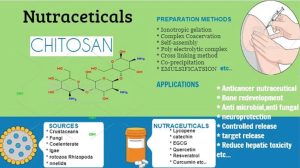
Advancement in the field of modern technology has curx toward the development of chitosan microparticles subsequently developing chitosan nanoparticles, ensuring the effective use of chitosan in diligence to varying industries. Chitosan nanoparticles poses a prime role due to their potential advantages, including ease of manipulation owing to functional surface groups, easy to surface functionalization, outstanding physicochemical properties, excellent biocompatibility and biodegradability.
This chapter discusses chitosan nanoparticles in detail to its intricate physical, chemical, and biological/green methods for the preparation, physicochemical characteristics, different nano-formulations, mainly focusing its nutraceutical applications. In association with recent implementation of green synthesis of chitosan based nutraceuticals poses nontoxic, eco-friendly, and biosafety in production field.
Malathi, T., Sivakkumar, T., Surendra Kumar, M. (2024). Chitosan-Based Nano-Delivery System. In: Rajakumari, R., Thomas, S. (eds) Handbook of Nutraceuticals. Springer, Cham. https://doi.org/10.1007/978-3-030-69677-1_34-2
Chapter 5
Emulsions Suspensions and Nanonutraceutical Formulations and Evaluation of Nutraceuticals
The Greek physician Hippocrates, often referred to as the “Father of Medicine,” said “let food be your medicine.” The philosophy behind is focused on prevention. The huge wave that started during the 1990s in the United States has drastically changed the market trends for nutraceuticals. Consumers have started subscribing to diet regimens that reduce the risk of chronic diseases. People are using nutraceuticals and functional foods more for prevention than for the cure of diseases. After the industrial and communication revolutions, the lifestyles of humans are changing significantly. Everyone feels the scarcity of time, whether a young child or a retired adult.
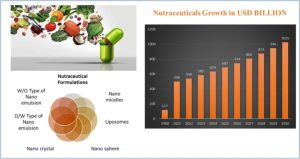
Earlier it was normal for a person to walk regularly a few miles; now lifestyles have changed, and there are fewer opportunities for people to walk or take regular exercise. Everyone is looking for alternative ways to keep healthy and trying to change their current lifestyles, leading to much healthier lifestyles. This is very well reflected in the growth of the nutraceutical and functional food market in the past decade. The growth of the nutraceutical food market from 2007 to 2013 was almost 142%, while that of nutraceutical supplements is estimated to increase by 125%, and nutraceutical beverages may increase by a whopping 185%. The nutraceutical market is predicted to record a revenue of USD 671.30 billion by 2024.
Developing countries have a high prevalence of noncommunicable diseases like cancer, diabetes, cardiovascular ailments, etc. Therefore, the demand for nutraceuticals is expected to rise in these nations. The gradually increasing healthcare expenses are also stimulating the demand for nutraceuticals.
Athilli, L., Koneru, A. (2024). Emulsions Suspensions and Nanonutraceutical Formulations and Evaluation of Nutraceuticals. In: Rajakumari, R., Thomas, S. (eds) Handbook of Nutraceuticals. Springer, Cham. https://doi.org/10.1007/978-3-030-69677-1_14-1
Chapter 6
Hot Melt Extrusion and Complex Coacervation System for Delivering Nutraceuticals and Nanonutraceuticals
Nutraceuticals or bioceuticals are termed as oral nutritional constituents considered to have a therapeutic or health benefit. Encapsulation technology has been used in pharmaceutical industry for drug delivery due to various reason, viz., improve bioactive delivery, packing solids, liquids, or gaseous materials in small capsules, lesser degradation of volatile compound, etc.
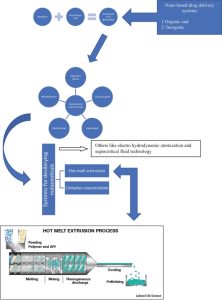
Inside the body various factors can compromise the biologically availability of a compound such as lesser gastric residence time, stability, permeability is very low, and difficulty in gastrointestinal (GI) tract solubility.
The delivery systems at various levels and micro- and nanoscale area have fascinated researchers worldwide. Nanocarriers are polymeric, lipid, carbon, metal, etc., based, which are potentially used as delivery tools for various drugs and management and treatment of diseases. Hot-melt extrusion and complex coacervation systems are techniques that are gaining its popularity in the field of nutraceutical industry and has various advantages over conventional processing techniques.
Hot melt extrusion technology is successfully adopted for the preparation of solid molecular dispersion of active pharmaceutical ingredients (APIs) whereas in complex coacervation process separation between the insoluble complex coacervates and the liquid will happen due to electrostatic binding between oppositely charged polymers.
Samyor, D., Haokip, N. (2024). Hot Melt Extrusion and Complex Coacervation System for Delivering Nutraceuticals and Nanonutraceuticals. In: Rajakumari, R., Thomas, S. (eds) Handbook of Nutraceuticals. Springer, Cham. https://doi.org/10.1007/978-3-030-69677-1_43-1
Chapter 14
Nutraceuticals and Nanonutraceuticals Formulation for Chronic Disease – Cancer
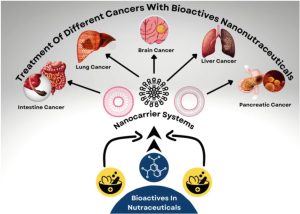
Nutraceuticals are extensively explored for management of various types of cancer. They are generally regarded to be neutral and safe and are widely used to promote overall health. Nutraceuticals offer numerous benefits by modifying and maintaining normal body physiological functions. However, the conventional nutraceutical formulations in the market have some major issues that limit their availability in vivo. Majority of the bioactives have limited aqueous solubility leading to poor bioavailability profile. With the advent of nanotechnology some of these limitations have been minimized in the past and investigators have succesfully utilized the benefits of nutraceuticals in vivo for management of cancer. This chapter emphasizes the concerns associated with nutraceuticals and various nanoscale formulation strategies like liposomes, nanoemulsions, nanocrystals, lipid, and polymeric nanoparticles to obtain an insight to how these help in sucessful delivery of bioactives in management of cancer.
Shahid, A., Ahmad, U., Islam, A., Ali, A., Khan, M.M. (2024). Nutraceuticals and Nanonutraceuticals Formulation for Chronic Disease – Cancer. In: Rajakumari, R., Thomas, S. (eds) Handbook of Nutraceuticals. Springer, Cham. https://doi.org/10.1007/978-3-030-69677-1_9-1
Chapter 16
Solutions, Aqueous Solutions, Juices and Syrups and Its Evaluation of Nutraceutical Formulation Contents
Intake of natural food has always been the key ingredient to keep the health in a well-maintained state. Medicines are needed in case of any sort of illness or disease (be it acute or chronic). Although pharmaceuticals are successful to cure disease and provide desired output and that too in a short span, allopathic medicines are made up of chemicals that could be injurious to the organs or the biological mechanisms in a long run. The modern human being has been trying to improve their lifestyle by relying primarily on natural resources and making efforts to show less dependence on drugs. Hence, the term nutraceuticals come from the combination of the terms nutrition and pharmaceuticals and are natural products providing nutrition and fulfill the role of medicines also without the involvement of major side effects.
Dietary supplements easily available in the market, baby food, multivitamins, and herbal drinks are some of the examples of nutraceuticals. Intake of nutraceuticals is possible in solid as well as in liquid form, be it as pills, capsules, syrups, or juices. Sometimes, the intake of nutraceuticals in solid form is difficult, mainly by infants, children, and old-aged people and a very small portion is absorbed by the body when compared with their liquid form where the latter can be easily consumed, digested, and maximum number of bioactive substances can be assimilated. Most nutraceuticals are composed of natural resources imparting significant properties like antioxidants and anti-inflammatory. In this chapter, we have highlighted the formulation of various forms of nutraceuticals and their evaluation by blending various natural resources such as fruit juices, green tea extracts, herbs, Rasayana, fish oil containing essential polyunsaturated omega-3 fatty acids, and their impact on the living body upon consumption.
Mittal, S., Anand, A., Chawla, H., Garg, S. (2024). Solutions, Aqueous Solutions, Juices and Syrups and Its Evaluation of Nutraceutical Formulation Contents. In: Rajakumari, R., Thomas, S. (eds) Handbook of Nutraceuticals. Springer, Cham. https://doi.org/10.1007/978-3-030-69677-1_13-1
See the full book here
R. Rajakumari, Sabu Thomas, Handbook of Nutraceuticals, SpringerLink, eBook ISBN 978-3-030-69677-1, Published: 16 May 2024, DOI: https://doi.org/10.1007/978-3-030-69677-1

